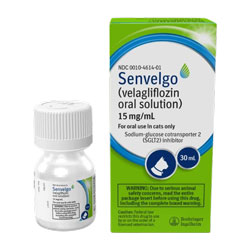Save on All Your Summer Essentials: From Calming Products to Flea & Tick Solutions and More!
Senvelgo (velagiflozin oral solution) for Cats
SKU : 168439_-RX

Price: $289.00
Veterinarian Prescription (Rx) Required
Free Shipping on orders over $75
Low Price Match Guarantee
- Oral solution
- Improves glycemic control
- Normalization of blood glucose
- Reduces glucose toxicity and peripheral insulin resistance in cats with sufficient endogenous insulin production
How to Order Prescriptions
Supports
Dosage and Administration
Senvelgo should be administered using the dosing syringe provided in the package. The dosing syringe fits onto the bottle and as a body weight scale with increments per pound of body weight. The dose should be rounded down to the nearest pound. After administration, close the bottle tightly with the cap. If needed, the syringe can be cleaned with a clean, dry cloth
Warnings
Not for use in humans. Keep out of reach of children, wash hands after use. This product may cause mild eye irritation. Avoid contact with eyes. If the product accidentally gets into the eyes, rinse eyes immediately with plenty of water; if wearing contact lenses, rinse the eyes first then remove contact lens(es) and continue to rinse for 5-10 minutes. If eye irritation continues or accidental ingestion occurs, seek medical advice and provide this product information to the physician. Exposure to product may induce local or systemic allergic reaction in sensitized individuals. Oral exposure to velagliflozin may cause transient effects such as increased renal glucose excretion, increased urine volume, and hypoglycemia
Description
SENVELGO® (velagliflozin oral solution) is a once-daily, liquid oral solution that can be administered directly into the cat’s mouth or applied onto a small amount of wet food.Indications
Is indicated to improve glycemic control in otherwise healthy cats with diabetes mellitus not previously treated with insulinSupports
- Reduces persistent hyperglycemia, leading to effective glycemic control in as soon as 1 week
- Minimal risk of clinical hypoglycemic events
- Precise dosing tailored to the cat’s weight
- Significantly reduces the need for blood glucose monitoring
- Well accepted by most cats
- Easy storage—no refrigeration needed before or after opening
Dosage and Administration
Senvelgo should be administered using the dosing syringe provided in the package. The dosing syringe fits onto the bottle and as a body weight scale with increments per pound of body weight. The dose should be rounded down to the nearest pound. After administration, close the bottle tightly with the cap. If needed, the syringe can be cleaned with a clean, dry cloth Warnings
Not for use in humans. Keep out of reach of children, wash hands after use. This product may cause mild eye irritation. Avoid contact with eyes. If the product accidentally gets into the eyes, rinse eyes immediately with plenty of water; if wearing contact lenses, rinse the eyes first then remove contact lens(es) and continue to rinse for 5-10 minutes. If eye irritation continues or accidental ingestion occurs, seek medical advice and provide this product information to the physician. Exposure to product may induce local or systemic allergic reaction in sensitized individuals. Oral exposure to velagliflozin may cause transient effects such as increased renal glucose excretion, increased urine volume, and hypoglycemia







